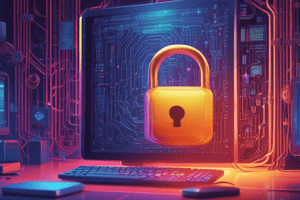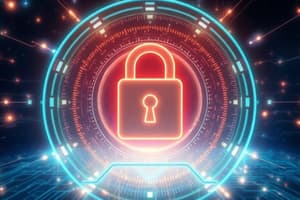Podcast
Questions and Answers
What is the primary purpose of allowing temporary password use for system logons?
What is the primary purpose of allowing temporary password use for system logons?
- To improve system security permanently
- To enhance user experience
- To facilitate immediate change to a permanent password (correct)
- To simplify the authentication process
Which of the following is classified as a dynamic biometric authentication method?
Which of the following is classified as a dynamic biometric authentication method?
- Face recognition
- Voice pattern (correct)
- Retina scan
- Fingerprint
What does multifactor authentication (MFA) require from a user?
What does multifactor authentication (MFA) require from a user?
- Only possession of a token
- One piece of evidence for verification
- A password shared with the system admin
- Two or more pieces of evidence for verification (correct)
Which level of Identity Assurance Level (IAL) requires physical presence for identity proofing?
Which level of Identity Assurance Level (IAL) requires physical presence for identity proofing?
What type of passwords should be stored and transmitted according to best practices?
What type of passwords should be stored and transmitted according to best practices?
Which of the following is NOT a mean of authenticating a user's identity?
Which of the following is NOT a mean of authenticating a user's identity?
At which Authenticator Assurance Level (AAL) is some assurance of authentication provided via user-supplied ID and password?
At which Authenticator Assurance Level (AAL) is some assurance of authentication provided via user-supplied ID and password?
Which of the following best describes static biometrics?
Which of the following best describes static biometrics?
What is digital identity defined as?
What is digital identity defined as?
Which of the following is a basic security requirement for user authentication?
Which of the following is a basic security requirement for user authentication?
What is multifactor authentication primarily used for?
What is multifactor authentication primarily used for?
Which security measure is intended to prevent the reuse of identifiers?
Which security measure is intended to prevent the reuse of identifiers?
What does enforced password complexity imply?
What does enforced password complexity imply?
What is the purpose of replay-resistant authentication mechanisms?
What is the purpose of replay-resistant authentication mechanisms?
What is a consequence of having a defined period of inactivity for identifiers?
What is a consequence of having a defined period of inactivity for identifiers?
Which of the following statements about password reuse is true?
Which of the following statements about password reuse is true?
What ensures that the contactless RF chip in the eID card cannot be accessed without authorization?
What ensures that the contactless RF chip in the eID card cannot be accessed without authorization?
Which method is commonly used to generate a time-based one-time password (TOTP)?
Which method is commonly used to generate a time-based one-time password (TOTP)?
What is the risk associated with a one-time password (OTP) device?
What is the risk associated with a one-time password (OTP) device?
In which scenario is the machine-readable zone (MRZ) primarily used?
In which scenario is the machine-readable zone (MRZ) primarily used?
What should systems using time-based OTP accommodate for successful authentication?
What should systems using time-based OTP accommodate for successful authentication?
Which component of an OTP device is crucial for securely generating the password?
Which component of an OTP device is crucial for securely generating the password?
What is the purpose of the personal identification number (PIN) in the context of eID cards?
What is the purpose of the personal identification number (PIN) in the context of eID cards?
What distinguishes single-factor authentication from other methods?
What distinguishes single-factor authentication from other methods?
What function does the eID PIN serve in online applications?
What function does the eID PIN serve in online applications?
Which of the following data can be accessed or read by eID functions?
Which of the following data can be accessed or read by eID functions?
What is the purpose of the electronic signature creation in eID?
What is the purpose of the electronic signature creation in eID?
What information would be typically included in an eID revocation query?
What information would be typically included in an eID revocation query?
Which of the following is NOT a function of eID?
Which of the following is NOT a function of eID?
What is one of the uses of the signature key in electronic signatures?
What is one of the uses of the signature key in electronic signatures?
In the context of eID, what does 'PAC E Password' refer to?
In the context of eID, what does 'PAC E Password' refer to?
Which of the following options relates to community ID verification in eID functions?
Which of the following options relates to community ID verification in eID functions?
What is a potential disadvantage of using mobile authentication apps?
What is a potential disadvantage of using mobile authentication apps?
Which attack method specifically targets a mobile user's access to their authentication?
Which attack method specifically targets a mobile user's access to their authentication?
What unique characteristic is NOT used in biometric authentication?
What unique characteristic is NOT used in biometric authentication?
What type of protocol is generally used to enhance security during remote user authentication?
What type of protocol is generally used to enhance security during remote user authentication?
Which of the following is a challenge faced specifically by remote user authentication?
Which of the following is a challenge faced specifically by remote user authentication?
What is a common defense against password guessing attacks?
What is a common defense against password guessing attacks?
What type of attack attempts to disable a user authentication service through an overload?
What type of attack attempts to disable a user authentication service through an overload?
Which biometric matching method is considered technically complex and expensive?
Which biometric matching method is considered technically complex and expensive?
What is a risk associated with attackers using fake mobile towers?
What is a risk associated with attackers using fake mobile towers?
In the context of client attacks, what is a common method attackers use to achieve unauthorized access?
In the context of client attacks, what is a common method attackers use to achieve unauthorized access?
Flashcards are hidden until you start studying
Study Notes
Digital User Authentication Principles
- Digital identity is a unique representation of a subject in online transactions (NIST SP 800-63-3).
- Digital user authentication determines the validity of authenticators claiming a digital identity.
- Basic security requirements include identifying users, authenticating identities, and employing multifactor authentication (MFA).
Password-Based Authentication
- Requires users to authenticate with something they know, such as a password or PIN.
- Security measures include enforcing complexity, preventing reuse, and disabling inactive accounts.
Token-Based Authentication
- Users authenticate with something they possess, like a smartcard or electronic keycard.
- One-time passwords (OTP) generated by devices increase security for transactions.
- Alternatives like time-based OTP (TOTP) rely on algorithms and a secure clock, but vulnerable to clock drift issues.
Biometric Authentication
- Utilizes unique physical characteristics (e.g., fingerprints, facial recognition) for user authentication.
- Technically complex and expensive compared to traditional methods, yet provides heightened security.
Multifactor Authentication (MFA)
- MFA involves using two or more factors for identity verification, such as passwords combined with tokens or biometrics.
- Enhances security compared to single-factor authentication methods.
Assurance Levels for User Authentication
- Identity Assurance Levels (IAL) define certainty in identity proofing:
- IAL1: No link to real identity required.
- IAL2: Evidence of identity through remote or in-person proofing.
- IAL3: Physical presence is needed for proofing.
- Authenticator Assurance Levels (AAL) gauge authentication strength:
- AAL1: User ID and password provide some assurance.
- Higher levels require stronger proof mechanisms.
Security Issues for User Authentication
- User authentication is subject to attacks like eavesdropping, replay attacks, and client/host attacks.
- Common attacks include password guessing, token theft, and biometric spoofing.
- Defense strategies involve multifactor authentication, large entropy for identifiers, and rigorous password protection measures.
Remote User Authentication Challenges
- Increased complexity and vulnerability over networks due to threats like capturing passwords and replaying authentication sequences.
- Challenge-response protocols can mitigate some security risks associated with remote authentication.
Case Study: ATM Security Problems
- Small to mid-sized debit card issuers often rely on processors for core data processing and electronic funds transfer, leading to potential vulnerabilities in ATM security.
Studying That Suits You
Use AI to generate personalized quizzes and flashcards to suit your learning preferences.





